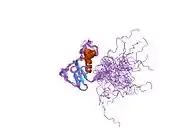POLR2F
DNA-directed RNA polymerases I, II, and III subunit RPABC2 is a protein that in humans is encoded by the POLR2F gene.[5]
This gene encodes the sixth largest subunit of RNA polymerase II, the polymerase responsible for synthesizing messenger RNA in eukaryotes, that is also shared by the other two DNA-directed RNA polymerases. In yeast, this polymerase subunit, in combination with at least two other subunits, forms a structure that stabilizes the transcribing polymerase on the DNA template.[6]
See also
References
- GRCh38: Ensembl release 89: ENSG00000100142 - Ensembl, May 2017
- GRCm38: Ensembl release 89: ENSMUSG00000033020 - Ensembl, May 2017
- "Human PubMed Reference:". National Center for Biotechnology Information, U.S. National Library of Medicine.
- "Mouse PubMed Reference:". National Center for Biotechnology Information, U.S. National Library of Medicine.
- Pusch C, Wang Z, Roe B, Blin N (September 1996). "Genomic structure of the RNA polymerase II small subunit (hRPB14.4) locus (POLRF) and mapping to 22q13.1 by sequence identity". Genomics. 34 (3): 440–2. doi:10.1006/geno.1996.0312. PMID 8786150.
- "Entrez Gene: POLR2F polymerase (RNA) II (DNA directed) polypeptide F".
- Acker, J; de Graaff M; Cheynel I; Khazak V; Kedinger C; Vigneron M (July 1997). "Interactions between the human RNA polymerase II subunits". J. Biol. Chem. UNITED STATES. 272 (27): 16815–21. doi:10.1074/jbc.272.27.16815. ISSN 0021-9258. PMID 9201987.
Further reading
- Jeang KT (1998). "Tat, Tat-associated kinase, and transcription". J. Biomed. Sci. 5 (1): 24–7. doi:10.1007/BF02253352. PMID 9570510.
- Yankulov K, Bentley D (1998). "Transcriptional control: Tat cofactors and transcriptional elongation". Curr. Biol. 8 (13): R447–9. doi:10.1016/S0960-9822(98)70289-1. PMID 9651670.
- Romano G, Kasten M, De Falco G, et al. (2000). "Regulatory functions of Cdk9 and of cyclin T1 in HIV tat transactivation pathway gene expression". J. Cell. Biochem. 75 (3): 357–68. doi:10.1002/(SICI)1097-4644(19991201)75:3<357::AID-JCB1>3.0.CO;2-K. PMID 10536359. S2CID 43685090.
- Marcello A, Zoppé M, Giacca M (2002). "Multiple modes of transcriptional regulation by the HIV-1 Tat transactivator". IUBMB Life. 51 (3): 175–81. doi:10.1080/152165401753544241. PMID 11547919. S2CID 10931640.
- Stevens M, De Clercq E, Balzarini J (2007). "The regulation of HIV-1 transcription: molecular targets for chemotherapeutic intervention". Med Res Rev. 26 (5): 595–625. doi:10.1002/med.20081. PMC 7168390. PMID 16838299.
- Harrich D, McMillan N, Munoz L, et al. (2007). "Will diverse Tat interactions lead to novel antiretroviral drug targets?". Current Drug Targets. 7 (12): 1595–606. doi:10.2174/138945006779025338. PMID 17168834.
- Kato H, Sumimoto H, Pognonec P, et al. (1992). "HIV-1 Tat acts as a processivity factor in vitro in conjunction with cellular elongation factors". Genes Dev. 6 (4): 655–66. doi:10.1101/gad.6.4.655. PMID 1559613.
- Southgate C, Zapp ML, Green MR (1990). "Activation of transcription by HIV-1 Tat protein tethered to nascent RNA through another protein". Nature. 345 (6276): 640–2. Bibcode:1990Natur.345..640S. doi:10.1038/345640a0. PMID 2190099. S2CID 4233742.
- Wu-Baer F, Sigman D, Gaynor RB (1995). "Specific binding of RNA polymerase II to the human immunodeficiency virus trans-activating region RNA is regulated by cellular cofactors and Tat". Proc. Natl. Acad. Sci. U.S.A. 92 (16): 7153–7. Bibcode:1995PNAS...92.7153W. doi:10.1073/pnas.92.16.7153. PMC 41297. PMID 7638159.
- Acker J, Wintzerith M, Vigneron M, Kedinger C (1995). "A 14.4 KDa acidic subunit of human RNA polymerase II with a putative leucine-zipper". DNA Seq. 4 (5): 329–31. doi:10.3109/10425179409020860. PMID 7803819.
- Herrmann CH, Rice AP (1995). "Lentivirus Tat proteins specifically associate with a cellular protein kinase, TAK, that hyperphosphorylates the carboxyl-terminal domain of the large subunit of RNA polymerase II: candidate for a Tat cofactor". J. Virol. 69 (3): 1612–20. doi:10.1128/JVI.69.3.1612-1620.1995. PMC 188757. PMID 7853496.
- Keen NJ, Gait MJ, Karn J (1996). "Human immunodeficiency virus type-1 Tat is an integral component of the activated transcription-elongation complex". Proc. Natl. Acad. Sci. U.S.A. 93 (6): 2505–10. Bibcode:1996PNAS...93.2505K. doi:10.1073/pnas.93.6.2505. PMC 39827. PMID 8637904.
- Yang X, Herrmann CH, Rice AP (1996). "The human immunodeficiency virus Tat proteins specifically associate with TAK in vivo and require the carboxyl-terminal domain of RNA polymerase II for function". J. Virol. 70 (7): 4576–84. doi:10.1128/JVI.70.7.4576-4584.1996. PMC 190394. PMID 8676484.
- Agostini I, Navarro JM, Rey F, et al. (1996). "The human immunodeficiency virus type 1 Vpr transactivator: cooperation with promoter-bound activator domains and binding to TFIIB". J. Mol. Biol. 261 (5): 599–606. doi:10.1006/jmbi.1996.0485. PMID 8800208.
- Zhou Q, Sharp PA (1996). "Tat-SF1: cofactor for stimulation of transcriptional elongation by HIV-1 Tat". Science. 274 (5287): 605–10. Bibcode:1996Sci...274..605Z. doi:10.1126/science.274.5287.605. PMID 8849451. S2CID 13266489.
- Okamoto H, Sheline CT, Corden JL, et al. (1996). "Trans-activation by human immunodeficiency virus Tat protein requires the C-terminal domain of RNA polymerase II". Proc. Natl. Acad. Sci. U.S.A. 93 (21): 11575–9. Bibcode:1996PNAS...9311575O. doi:10.1073/pnas.93.21.11575. PMC 38099. PMID 8876177.
- Chun RF, Jeang KT (1996). "Requirements for RNA polymerase II carboxyl-terminal domain for activated transcription of human retroviruses human T-cell lymphotropic virus I and HIV-1". J. Biol. Chem. 271 (44): 27888–94. doi:10.1074/jbc.271.44.27888. PMID 8910388.
- Parada CA, Roeder RG (1996). "Enhanced processivity of RNA polymerase II triggered by Tat-induced phosphorylation of its carboxy-terminal domain". Nature. 384 (6607): 375–8. Bibcode:1996Natur.384..375P. doi:10.1038/384375a0. PMID 8934526. S2CID 4278432.
- García-Martínez LF, Ivanov D, Gaynor RB (1997). "Association of Tat with purified HIV-1 and HIV-2 transcription preinitiation complexes". J. Biol. Chem. 272 (11): 6951–8. doi:10.1074/jbc.272.11.6951. PMID 9054383.
This article is issued from Wikipedia. The text is licensed under Creative Commons - Attribution - Sharealike. Additional terms may apply for the media files.






